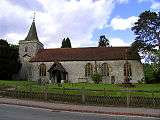All My Hope on God is Founded
| "Meine Hoffnung stehet feste" | |
|---|---|
| Hymn | |
| Written | c. 1680 |
| Text | by Joachim Neander |
| Language | German |
| Meter | 87 87 33 7 |
| "All My Hope on God is Founded" | |
|---|---|
 Church in Yattendon, where the translator worked who authored the Yattendon Hymnal | |
| Written | 1899 |
| Text | by Robert S. Bridges (translator) |
| Melody |
|
| Published | 1936 |
"All My Hope on God is Founded" is a well-known hymn, originally German, which was translated into English in 1899 and which established itself in the latter part of the twentieth century.
History
Words
The original words "Meine Hoffnung stehet feste" were written in around 1680 by Joachim Neander.

In 1899 these were translated into English by Robert Bridges, who would later become British Poet Laureate. He was, at the time, living in the Berkshire village of Yattendon, where he was choir master for the parish church of St Peter and St Paul.[1] Disappointed with range of hymns available, he made his own collection which he entitled the Yattendon Hymnal and included this hymn, number 69.[2][3]
Music
The original tune was a German chorale melody named Meine Hoffnung (from its German text). This tune was also used as the principal choice for the Methodist Hymns and Psalms book of 1983.
The hymn's popularity increased when its pairing with a tune Michael by the English composer Herbert Howells became more widely known.[4] Howells' son, Michael, born in 1925, had died in childhood in 1935 from spinal meningitis. It is believed that shortly after this, in 1936, Howells received a request for a new hymn tune in the morning's post, and he is said to have written the tune, which he named after his late son, over breakfast.
The tune first appeared in 1936 in the Clarendon Hymn Book, but its use remained largely confined in public school (independent) use in Britain for the next thirty years or so.
Its popularity began to spread in 1969 when it was included in the "100 Hymns for Today" supplement of the Hymns Ancient and Modern, one of the standard Church of England hymnbooks of its day. The Methodist church included it (albeit as second choice) in the 1983 Hymns and Psalms, and it was the main choice in the 1986 New English Hymnal. It has subsequently appeared in many hymnbooks across the English-speaking world.